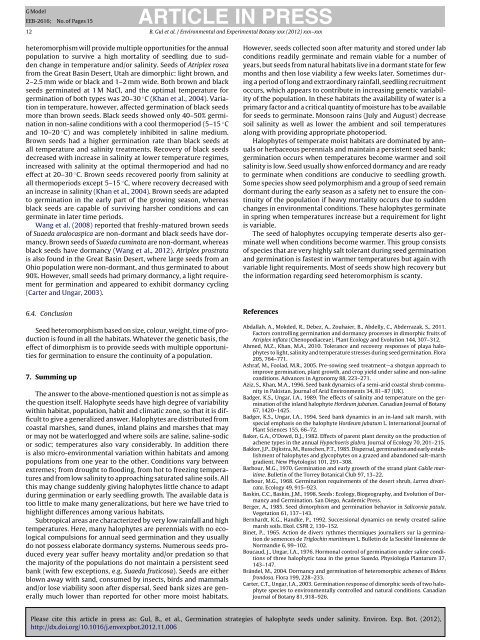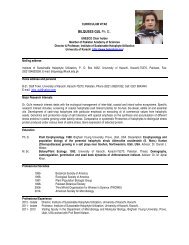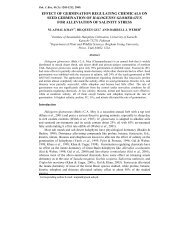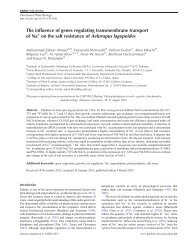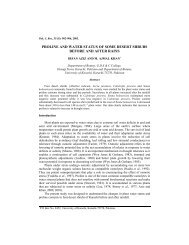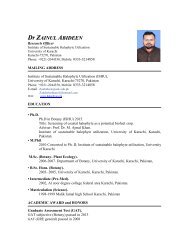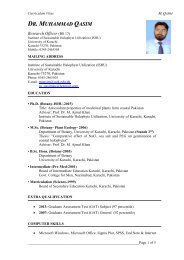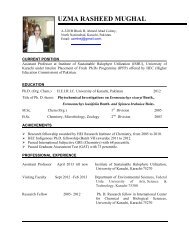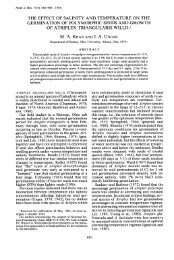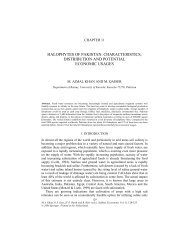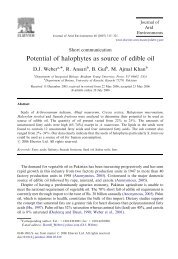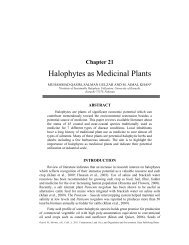ARTICLE IN PRESS G Model EEB-2616; No. <strong>of</strong> Pages 15 12 B. Gul et al. / Environmental and Experimental Botany xxx (2012) xxx–xxx heteromorphism will provide multiple opportunities for the annual population to survive a high mortality <strong>of</strong> seedling due to sudden change in temperature and/or salinity. Seeds <strong>of</strong> Atriplex rosea from the Great Basin Desert, Utah are dimorphic: light brown, and 2–2.5 mm wide or black and 1–2 mm wide. Both brown and black <strong>seeds</strong> germinated at 1 M NaCl, and the optimal temperature for germination <strong>of</strong> both types was 20–30 ◦ C (Khan et al., 2004). Variation in temperature, however, affected germination <strong>of</strong> black <strong>seeds</strong> more than brown <strong>seeds</strong>. Black <strong>seeds</strong> showed only 40–50% germination in non-saline conditions with a cool thermoperiod (5–15 ◦ C and 10–20 ◦ C) and was completely inhibited in saline medium. Brown <strong>seeds</strong> had a higher germination rate than black <strong>seeds</strong> at all temperature and salinity treatments. Recovery <strong>of</strong> black <strong>seeds</strong> decreased with increase in salinity at lower temperature regimes, increased with salinity at the optimal thermoperiod and had no effect at 20–30 ◦ C. Brown <strong>seeds</strong> recovered poorly from salinity at all thermoperiods except 5–15 ◦ C, where recovery decreased with an increase in salinity (Khan et al., 2004). Brown <strong>seeds</strong> are adapted to germination in the early part <strong>of</strong> the growing season, whereas black <strong>seeds</strong> are capable <strong>of</strong> surviving harsher conditions and can germinate in later time periods. Wang et al. (2008) reported that freshly-matured brown <strong>seeds</strong> <strong>of</strong> Suaeda aralocaspica are non-dormant and black <strong>seeds</strong> have dormancy. Brown <strong>seeds</strong> <strong>of</strong> Suaeda cuminata are non-dormant, whereas black <strong>seeds</strong> have dormancy (Wang et al., 2012). Atriplex prostrata is also found in the Great Basin Desert, where large <strong>seeds</strong> from an Ohio population were non-dormant, and thus germinated to about 90%. However, small <strong>seeds</strong> had primary dormancy, a light requirement for germination and appeared to exhibit dormancy cycling (Carter and Ungar, 2003). However, <strong>seeds</strong> collected soon after maturity and stored <strong>under</strong> lab conditions readily germinate and remain viable for a number <strong>of</strong> years, but <strong>seeds</strong> from natural habitats live in a dormant state for few months and then lose viability a few weeks later. Sometimes during a period <strong>of</strong> long and extraordinary rainfall, seedling recruitment occurs, which appears to contribute in increasing genetic variability <strong>of</strong> the population. In these habitats the availability <strong>of</strong> water is a primary factor and a critical quantity <strong>of</strong> moisture has to be available for <strong>seeds</strong> to germinate. Monsoon rains (July and August) decrease soil salinity as well as lower the ambient and soil temperatures along with providing appropriate photoperiod. Halophytes <strong>of</strong> temperate moist habitats are dominated by annuals or herbaceous perennials and maintain a persistent seed bank; germination occurs when temperatures become warmer and soil salinity is low. Seed usually show enforced dormancy and are ready to germinate when conditions are conducive to seedling growth. Some species show seed polymorphism and a group <strong>of</strong> seed remain dormant during the early season as a safety net to ensure the continuity <strong>of</strong> the population if heavy mortality occurs due to sudden changes in environmental conditions. These <strong>halophyte</strong>s germinate in spring when temperatures increase but a requirement for light is variable. The seed <strong>of</strong> <strong>halophyte</strong>s occupying temperate deserts also germinate well when conditions become warmer. This group consists <strong>of</strong> species that are very highly salt tolerant during seed germination and germination is fastest in warmer temperatures but again with variable light requirements. Most <strong>of</strong> <strong>seeds</strong> show high recovery but the information regarding seed heteromorphism is scanty. 6.4. Conclusion Seed heteromorphism based on size, colour, weight, time <strong>of</strong> production is found in all the habitats. Whatever the genetic basis, the effect <strong>of</strong> dimorphism is to provide <strong>seeds</strong> with multiple opportunities for germination to ensure the continuity <strong>of</strong> a population. 7. Summing up The answer to the above-mentioned question is not as simple as the question itself. Halophyte <strong>seeds</strong> have high degree <strong>of</strong> variability within habitat, population, habit and climatic zone, so that it is difficult to give a generalized answer. Halophytes are distributed from coastal marshes, sand dunes, inland plains and marshes that may or may not be waterlogged and where soils are saline, saline-sodic or sodic; temperatures also vary considerably. In addition there is also micro-environmental variation within habitats and among populations from one year to the other. Conditions vary between extremes; from drought to flooding, from hot to freezing temperatures and from low salinity to approaching saturated saline soils. All this may change suddenly giving <strong>halophyte</strong>s little chance to adapt during germination or early seedling growth. The available data is too little to make many generalizations, but here we have tried to highlight differences among various habitats. Subtropical areas are characterized by very low rainfall and high temperatures. Here, many <strong>halophyte</strong>s are perennials with no ecological compulsions for annual seed germination and they usually do not possess elaborate dormancy systems. Numerous <strong>seeds</strong> produced every year suffer heavy mortality and/or predation so that the majority <strong>of</strong> the populations do not maintain a persistent seed bank (with few exceptions, e.g. Suaeda fruticosa). Seeds are either blown away with sand, consumed by insects, birds and mammals and/or lose viability soon after dispersal. Seed bank sizes are generally much lower than reported for other more moist habitats. References Abdallah, A., Mokded, R., Debez, A., Zouhaier, B., Abdelly, C., Abderrazak, S., 2011. Factors controlling germination and dormancy processes in dimorphic fruits <strong>of</strong> Atriplex inflata (Chenopodiaceae). Plant Ecology and Evolution 144, 307–312. Ahmed, M.Z., Khan, M.A., 2010. Tolerance and recovery responses <strong>of</strong> playa <strong>halophyte</strong>s to light, salinity and temperature stresses during seed germination. Flora 205, 764–771. Ashraf, M., Foolad, M.R., 2005. Pre-sowing seed treatment—a shotgun approach to improve germination, plant growth, and crop yield <strong>under</strong> saline and non-saline conditions. Advances in Agronomy 88, 223–271. Aziz, S., Khan, M.A., 1996. Seed bank dynamics <strong>of</strong> a semi-arid coastal shrub community in Pakistan. Journal <strong>of</strong> Arid Environments 34, 81–87 (UK). Badger, K.S., Ungar, I.A., 1989. The effects <strong>of</strong> salinity and temperature on the germination <strong>of</strong> the inland <strong>halophyte</strong> Hordeum jubatum. Canadian Journal <strong>of</strong> Botany 67, 1420–1425. Badger, K.S., Ungar, I.A., 1994. Seed bank dynamics in an in-land salt marsh, with special emphasis on the <strong>halophyte</strong> Hordeum jubatum L. International Journal <strong>of</strong> Plant Sciences 155, 66–72. Baker, G.A., O’Dowd, D.J., 1982. Effects <strong>of</strong> parent plant density on the production <strong>of</strong> achene types in the annual Hypochoeris glabra. Journal <strong>of</strong> Ecology 70, 201–215. Bakker, J.P., Dijkstra, M., Russchen, P.T., 1985. Dispersal, germination and early establishment <strong>of</strong> <strong>halophyte</strong>s and glycophytes on a grazed and abandoned salt-marsh gradient. New Phytologist 101, 291–308. Barbour, M.G., 1970. <strong>Germination</strong> and early growth <strong>of</strong> the strand plant Cakile maritime. Bulletin <strong>of</strong> the Torrey Botanical Club 97, 13–22. Barbour, M.G., 1968. <strong>Germination</strong> requirements <strong>of</strong> the desert shrub, Larrea divaricata. Ecology 49, 915–923. Baskin, C.C., Baskin, J.M., 1998. Seeds: Ecology, Biogeography, and Evolution <strong>of</strong> Dormancy and <strong>Germination</strong>. San Diego, Academic Press. Berger, A., 1985. Seed dimorphism and germination behavior in Salicornia patula. Vegetation 61, 137–143. Bernhardt, K.G., Handke, P., 1992. Successional dynamics on newly created saline marsh soils. Ekol. CSFR 2, 139–152. Binet, P., 1965. Action de divers rythmes thermiques journaliers sur la germination de semences de Triglochin maritimum L. Bulletin de la Société linnéenne de Normandie 6, 99–102. Boucaud, J., Ungar, I.A., 1976. Hormonal control <strong>of</strong> germination <strong>under</strong> saline conditions <strong>of</strong> three halophytic taxa in the genus Suaeda. Physiologia Plantarum 37, 143–147. Brändel, M., 2004. Dormancy and germination <strong>of</strong> heteromorphic achenes <strong>of</strong> Bidens frondosa. Flora 199, 228–233. Carter, C.T., Ungar, I.A., 2003. <strong>Germination</strong> response <strong>of</strong> dimorphic <strong>seeds</strong> <strong>of</strong> two <strong>halophyte</strong> species to environmentally controlled and natural conditions. Canadian Journal <strong>of</strong> Botany 81, 918–926. Please cite this article in press as: Gul, B., et al., <strong>Germination</strong> <strong>strategies</strong> <strong>of</strong> <strong>halophyte</strong> <strong>seeds</strong> <strong>under</strong> salinity. Environ. Exp. Bot. (2012), http://dx.doi.org/10.1016/j.envexpbot.2012.11.006
G Model EEB-2616; No. <strong>of</strong> Pages 15 ARTICLE IN PRESS B. Gul et al. / Environmental and Experimental Botany xxx (2012) xxx–xxx 13 Chang, S.J., Zuo, B., Wang, X.W., Huang, J.H., 2008. Influence <strong>of</strong> light, temperature and salt on the germination <strong>of</strong> Salsola nitraria Pall. Arid Land Geog., doi:CNKI:SUN:GHDL.0.2008-06-016. Chapman, V.J., 1960. Salt Marshes and Salt Deserts <strong>of</strong> the World. Interscience Publishers, New York. Cheplick, G.P., 1994. Life history evolution in amphicarpic plants. Plant Species Biology 9, 119–131. Clarke, L.D., West, N.E., 1969. <strong>Germination</strong> <strong>of</strong> Kochia americana in relation to salinity. Agronomy Journal 20, 286–287. Darwin, C., 1857. On the action <strong>of</strong> sea-water on the germination <strong>of</strong> <strong>seeds</strong>. Journal <strong>of</strong> the Linnean Society 1, 130–140. Datta, S.C., 1965. <strong>Germination</strong> <strong>of</strong> <strong>seeds</strong> <strong>of</strong> two arid zone species. Bulletin <strong>of</strong> the Botanical Society <strong>of</strong> Bengal 19, 51–53. De Villiers, A.J., Van Rooyen, M.W., Theron, G.K., Van De Venter, H.A., 1994. <strong>Germination</strong> <strong>of</strong> three Namaqualand pioneer species, as influenced by salinity, temperature and light. Seed Science and Technology 22, 427–433. Debez, A., Hamed, K.B., Grignon, C., Abdelly, C., 2004. Salinity effect on germination, growth, and seed production <strong>of</strong> the <strong>halophyte</strong> Cakile maritima. Plant Soil 262, 179–189. Duan, D., Liu, X., Khan, M.A., Gul, B., 2004. Effects <strong>of</strong> salt and water stress on the seed germination <strong>of</strong> Chenopodium glaucum L. Pakistan Journal <strong>of</strong> Botany 36, 793–800. El-Keblawy, A., 2003. Effects <strong>of</strong> achene dimorphism on dormancy and progeny traits in the two ephemerals Hedypnois cretica and Crepis aspera (Asteraceae). Canadian Journal <strong>of</strong> Botany 81, 550–559. El-Keblawy, A., Al-Ansari, F., Al-Shamsi, N., 2011a. Effects <strong>of</strong> temperature and light on salinity tolerance during germination in two desert glycophytic grasses, Lasiurus scindicus and Panicum turgidum. Grass and Forage Science 66, 173–182. El-Keblawy, A., Al-Neyadi, S.S., Rao, M.V., Al-Marzouqi, A., 2011b. Interactive effects <strong>of</strong> salinity, light and temperature on seed germination <strong>of</strong> sand dunes glycophyte Cyprus conglomeratus growing in the United Arab Emirates deserts. Seed Science and Technology 39, 364–376. El-Keblawy, A., Al-Rawai, A., 2005. Effects <strong>of</strong> salinity, temperature and light on germination <strong>of</strong> invasive Prosopis juliflora (SW.) D.C. Journal <strong>of</strong> Arid Environments 61, 555–565. El-Keblawy, A., Al-Shamsi, N., 2008. Effects <strong>of</strong> salinity, temperature and light on seed germination <strong>of</strong> Haloxylon salicornicum, a common perennial shrub <strong>of</strong> the Arabian deserts. Seed Science and Technology 36, 679–688. Elsey-Quirk, T., Middleton, B.A., Edward-Pr<strong>of</strong>fit, C., 2009. Seed flotation and germination <strong>of</strong> salt marsh plants: the effects <strong>of</strong> stratification, salinity, and/or inundation regime. Aquatic Botany 91, 40–46. Freeman, C.E., 1973. <strong>Germination</strong> responses <strong>of</strong> a Texas population <strong>of</strong> Octillo (Fouquieria splendens Engelm.) to constant temperature, water stress, pH and salinity. American Midland Naturalist 89, 252–256. Galinato, M.I., van der Valk, A.G., 1986. Seed germination traits <strong>of</strong> annuals and emergents recruited during drawdowns in the Delta marsh, Manitoba, Canada. Aquatic Botany 26, 89–102. Grouzis, M., Berger, A., Heim, G., 1976. Polymorphisme et germination des graines hez trois especes annuelles du genre Salicornia. Oecologia Planta 11, 41–45. Guan, B., Yu, J., Lu, Z., Japhet, W., Chen, X., Xie, W., 2010. Salt tolerance in two Suaeda species: seed germination and physiological responses. Asian Journal <strong>of</strong> Plant Sciences 9, 194–199. Gul, B., Khan, M.A., 1998. Population characteristics <strong>of</strong> a coastal <strong>halophyte</strong> Arthrocnemum macrostachyum. Pakistan Journla <strong>of</strong> Botany 30, 189–197. Gul, B., Khan, M.A., 2006. Role <strong>of</strong> calcium in alleviating salinity effects in sub-tropical <strong>halophyte</strong>s. In: Khan, M.A., Weber, D.J. (Eds.), Ecophysiology <strong>of</strong> High Salinity Tolerant Plants. Springer, Netherlands, pp. 107–114. Gul, B., Khan, M.A., Weber, D.J., 2000. Alleviation salinity and dark-enforced dormancy in Allenrolfea occidentalis <strong>seeds</strong> <strong>under</strong> various thermoperiods. Australian Journal <strong>of</strong> Botany 48, 745–752. Gul, B., Weber, D.J., 1998. Role <strong>of</strong> dormancy relieving compounds and salinity on the seed germination <strong>of</strong> Allenrolfea occidentalis. Annals <strong>of</strong> Botany 82, 555–562. Gul, B., Weber, D.J., 1999. Effect <strong>of</strong> salinity, light, and thermoperiod on the seed germination <strong>of</strong> Allenrolfea occidentalis. Canadian Journal <strong>of</strong> Botany 77, 1–7. Gul, B., Weber, D.J., 2001. Seed bank dynamics in a Great Basin salt playa. Journal <strong>of</strong> Arid Environments 49, 785–879. Gulzar, S., Khan, M.A., 2001. Seed germination <strong>of</strong> a halophytic grass Aeluropus lagopoides. Annals <strong>of</strong> Botany 87, 319–324. Gulzar, S., Khan, M.A., Liu, X., 2007. Seed germination <strong>strategies</strong> <strong>of</strong> Desmostachya bipinnata: a fodder crop for saline soils. Rangeland Ecology & Management 60, 401–407. Gulzar, S., Khan, M.A., Ungar, I.A., 2001. Effect <strong>of</strong> temperature and salinity on the germination <strong>of</strong> Urochondra setulosa. Seed Science and Technology 29, 21–29. Guma, I.R., Padrón-Mederos, M.A., Santos-Guerra, A., Reyes-Betancort, J.A., 2010. Effect <strong>of</strong> temperature and salinity on germination <strong>of</strong> Salsola vermiculata L. (Chenopodiaceae) from Canary Islands. Journal <strong>of</strong> Arid Environments 74, 708–711. Gutterman, Y., Kamenetsky, R., Van Rooyen, M., 1995. A comparative study <strong>of</strong> seed germination <strong>of</strong> two Allium species from different habitats in the Negev desert highlands. Journal <strong>of</strong> Arid Environments 29, 305–315. Gutterrman, Y., 1993. Seed germination in desert plants. In: Adaptations <strong>of</strong> Desert Organisms. Springer, Berlin, 253 pp. Harivandi, M.A., Butler, J.D., Soltanpour, P.N., 1982. Effects <strong>of</strong> sea water concentrations on germination and ion accumulation in Alkali grass (Puccinellia spp.). Communications in Soil Science and Plant Analysis 13, 507–517. Harper, J.L., 1977. Population Biology <strong>of</strong> Plants. Academic Press, New York, USA. Hartman, J.M., 1988. Recolonization <strong>of</strong> small disturbance patches in a New England salt marsh. American Journal <strong>of</strong> Botany 75, 1625–1631. Huang, Z., Zhang, X., Zheng, G., Gutterman, Y., 2003. Influence <strong>of</strong> light, temperature, salinity and storage on seed germination <strong>of</strong> Haloxylon ammodendron. Journal <strong>of</strong> Arid Environments 55, 453–464. Hutchings, M.J., Russell, P.J., 1989. The seed regeneration dynamics <strong>of</strong> an emergent salt marsh. Journal <strong>of</strong> Ecology 77, 615–637. Ignaciuk, R., Lee, J.A., 1980. The germination <strong>of</strong> four annual strand-line species. New Phytologist 84, 581–587. Imbert, E., 2002. Ecological consequences and ontogeny <strong>of</strong> seed heteromorphism. Perspectives in Plant Ecology 5, 13–36. Joshi, A.J., Iyengar, E.R.R., 1982. Effect <strong>of</strong> salinity on the germination <strong>of</strong> Salicornia brachiata Roxb. Indian Journal <strong>of</strong> Plant Physiology 25, 65–70. Jutila, H.M.E., 1998. Effect <strong>of</strong> different treatments on the seed bank <strong>of</strong> grazed and ungrazed Baltic seashore meadows. Canadian Journal <strong>of</strong> Botany 76, 1188–1197. Katembe, W.J., Ungar, I.A., Mitchell, J.P., 1998. Effect <strong>of</strong> salinity on germination and seedling growth <strong>of</strong> two Atriplex species (Chenopodiaceae). Annals <strong>of</strong> Botany 82, 167–175. Keiffer, C.H., Ungar, I.A., 1997. The Effect <strong>of</strong> Extended Exposure to Hypersaline Conditions on the <strong>Germination</strong> <strong>of</strong> Five Inland Halophyte Species. American Journal <strong>of</strong> Botany 84, 104–111. Keiffer, C.W., Ungar, I.A., 1995. <strong>Germination</strong> responses <strong>of</strong> <strong>halophyte</strong> <strong>seeds</strong> exposed to prolonged hypersaline conditions. In: Khan, M.A., Ungar, I.A. (Eds.), Biology <strong>of</strong> salt tolerant plants, Department <strong>of</strong> Botany, University <strong>of</strong> Karachi, Pakistan, pp. 43–50. Keren, A., Evenari, M., 1974. Some ecological aspects <strong>of</strong> distribution and germination <strong>of</strong> Pancratium maritimum L. Israel Journal <strong>of</strong> Botany 23, 202–215. Khan, M.A., 1990. The relationship <strong>of</strong> seed bank to vegetation in a saline desert community. In: Sen, D.N., Mohammed, S. (Eds.), Marvel <strong>of</strong> Seeds. Proceeding <strong>of</strong> International Seed Symposium. Jodhpur, India, pp. 87–92. Khan, M.A., 1991. Studies on germination <strong>of</strong> Cressa cretica. Pakistan Journal <strong>of</strong> Weed Science Research 4, 89–98. Khan, M.A., 1993. Relationship <strong>of</strong> seed bank to plant distribution in saline arid communities. Pakistan Journal <strong>of</strong> Botany 25, 73–82. Khan, M.A., 1999. Comparative influence <strong>of</strong> salinity and temperature on the germination <strong>of</strong> subtropical <strong>halophyte</strong>s. In: Lieth, H., Moschenko, M., Lohman, M., Koyro, H.–W., Hamdy, A. (Eds.), Halophyte Uses in Different Climates. I: Ecological and Ecophysiological Studies. Progress in Biometeriology, Vol. 13. Backhuys Publishers, The Netherlands, pp. 77–88. Khan, M.A., Gul, B., 1998. High salt tolerance in germinating dimorphic <strong>seeds</strong> <strong>of</strong> Arthrocnemum indicum. International Journal <strong>of</strong> Plant Sciences 159, 826–832. Khan, M.A., Gul, B., 2002. Some ecophysiological aspects <strong>of</strong> seed germination in <strong>halophyte</strong>s. In: Liu, X., Liu, M. (Eds.), Halophyte Utilization and Regional Sustainable Development <strong>of</strong> Agriculture. Metereological Press, Beijing, China, pp. 56–68. Khan, M.A., Gul, B., 2006. Halophyte seed germination. In: Khan, M.A., Weber, D.J. (Eds.), Eco-physiology <strong>of</strong> High Salinity Tolerant Plants. Springer, Netherlands, pp. 11–30. Khan, M.A., Gul, B., Weber, D.J., 2000. <strong>Germination</strong> responses <strong>of</strong> Salicornia rubra to temperature and salinity. Journal <strong>of</strong> Arid Environments 45, 207–214. Khan, M.A., Gul, B., Weber, D.J., 2001a. <strong>Germination</strong> <strong>of</strong> dimorphic <strong>seeds</strong> <strong>of</strong> Suaeda moquinii <strong>under</strong> high salinity stress. Australian Journal <strong>of</strong> Botany 49, 185–192. Khan, M.A., Gul, B., Weber, D.J., 2001b. Effect <strong>of</strong> salinity and temperature on the germination <strong>of</strong> Kochia scoparia. Wetlands Ecology and Management 9, 483–489. Khan, M.A., Gul, B., Weber, D.J., 2002a. Seed germination in the Great Basin <strong>halophyte</strong> Salsola iberica. Canadian Journal <strong>of</strong> Botany 80, 650–655. Khan, M.A., Gul, B., Weber, D.J., 2002b. Effect <strong>of</strong> temperature and salinity on the germination <strong>of</strong> Sarcobatus vermiculatus. Biologia Plantarum 45, 133–135. Khan, M.A., Gul, B., Weber, D.J., 2001c. Seed germination characteristics <strong>of</strong> Halogeton glomeratus. Canadian Journal <strong>of</strong> Botany 79, 1189–1194. Khan, M.A., Ungar, I.A., Gul, B., 2003. Alleviation <strong>of</strong> salinity-enforced seed dormancy in Atriplexp rostrata. Pakistan Journal <strong>of</strong> Botany 36, 907–912. Khan, M.A., Gul, B., Weber, D.J., 2004. Temperature and high salinity effect in germinating dimorphic <strong>seeds</strong> <strong>of</strong> Atriplex rosea. Western North American Naturalist 64, 193–201. Khan, M.A., Gulzar, S., 2003. <strong>Germination</strong> responses <strong>of</strong> Sporobolus ioclados: a potential forage grass. Journal <strong>of</strong> Arid Environments 53, 387–394. Khan, M.A., Rizvi, Y., 1994. The effect <strong>of</strong> salinity, temperature and growth regulators on the germination and early seedling growth <strong>of</strong> Atriplex griffithii Moq.var. stocksii Boiss. Canadian Journal <strong>of</strong> Botany 72, 475–479. Khan, M.A., Sankhla, N., Weber, D.J., McArthur, E.D., 1987. Seed germination characteristics <strong>of</strong> Chrysothamnus nauseosus (Pallas) Britt.spp. viridulus (Astereae, Asteraceae). Great Basin Naturalist 47, 220–226. Khan, M.A., Ungar, I.A., 1984. Effects <strong>of</strong> salinity and temperature on the germination and growth <strong>of</strong> Atriplex triangularis Willd. American Journal <strong>of</strong> Botany 71, 481–489. Khan, M.A., Ungar, I.A., 1986a. Inhibition <strong>of</strong> germination in Atriplex triangularis <strong>seeds</strong> by application <strong>of</strong> phenols reversal <strong>of</strong> inhibition by growth regulators. Botanical Gazette 147, 148–151. Khan, M.A., Ungar, I.A., 1986b. Life history and population dynamics <strong>of</strong> Atriplex triangularis. Vegetation 66, 17–25. Khan, M.A., Ungar, I.A., 1996. Influence <strong>of</strong> salinity and temperature on the germination <strong>of</strong> Haloxylon recurvum. Annals <strong>of</strong> Botany 78, 547–551. Khan, M.A., Ungar, I.A., 1997a. Effect <strong>of</strong> thermoperiod on recovery <strong>of</strong> seed germination <strong>of</strong> <strong>halophyte</strong>s from saline conditions. American Journal <strong>of</strong> Botany 84, 279–283. Please cite this article in press as: Gul, B., et al., <strong>Germination</strong> <strong>strategies</strong> <strong>of</strong> <strong>halophyte</strong> <strong>seeds</strong> <strong>under</strong> salinity. Environ. Exp. Bot. (2012), http://dx.doi.org/10.1016/j.envexpbot.2012.11.006


